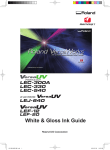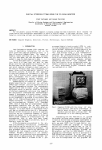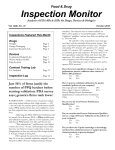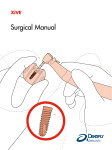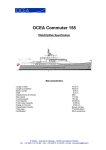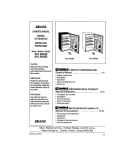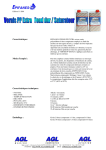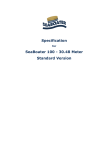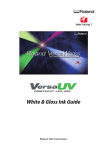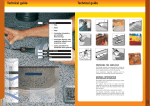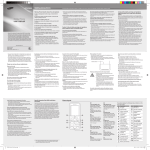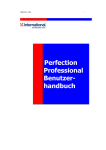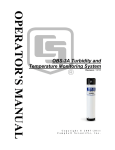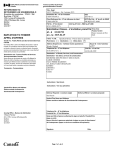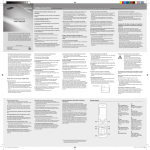Download A Spring Primer on Paints and Varnish
Transcript
F!TI[[JG I)";'! BY ANDREW BURTON A Spring Primer on Paints and Varnish With so many products on the shelf, do a little homework and find just the right one for your next boatyard projects IT'S SPRINGTIME, AND CHANCES are that if your sailboat was hauled last fall, you're facing at least one painting or varnishing project before it goes back in the water. There are basically four kinds of painting jobs: antifouling, topsides and decks, interiors, and 88 brightwork. Here's a head start on the sorts of finishes that are available, a few tips that will make your project less painful, and some resources to explore to learn more about products and techniques. Wood Treatments Different wood-finishing products are more or less difficult to use and yield results that tend to be proportional to the effort exerted in preparing the surface. Teak and mahogany are the most common woods used externally on boats, with oak being evident every now and again. MaCRUISING WORLD APRIL 2007 HANDS-ON SAILOR ---- hogany and oak must be sealed, or they'll blacken and eventually rot; varnish is the best finish for these woods, although some may choose paint instead. Teak is more flexible. Because of its natural oils, it can be left unfinished, and it will take on a silver color that some cruisers prefer because it requires no more attention than an occasional scrub with soap and water. If you plan to put a finish on your teak, you have to get it looking good first. If it's bare and has oxidized, you'll probably want to use one of the many teak cleaners before you sand. Beware, though: All of these will damage the teak to some extent. Use them sparingly, and bear in mind that you'll still have to sand the wood after using a cleaner; you just won't have to do as much of it as you would were you to sand off all the oxidation. When it's sanded and finished, teak takes on a gorgeous luster that's a pleasure to behold. There are, in general, three finishes that can be applied to teak: natural oil, synthetic sealers, and varnish. Oils penetrate into the wood and give it a rich glow when they're applied, but they're thin, so if you're not very careful, they can end up making a mess of the surrounding area. Most oils go on clear, so any spills won't show up until they've dried, and then they're hard to remove. Because most have few, if any, ultraviolet absorbers, the sun causes oil to deteriorate quickly, so the wood must be recoated several times a season to keep it looking good. Most natural oils Buy the Right Masking Tape W en painting and varnishing, you can achieve expensive tape and remove it daily. Don't use the typical straight lines and eliminate light-tan stuff outside. The runs and drips if you take the sun's rays will make it adhere time to properly mask off the to the surface you've taped off, area on which you're working. and chances are that you'll If you plan to do the whole have a very hard time remov- job in one go, use a long-last- ing it. It also has strong glue, ing masking tape. If you're so it'll often pull up the finish to which it adheres. going to spread the job over 90 several weeks, then use a less CRUISING WORLO ArRll 2007 z o.... 0: :> CD ;;: W 0: o z « Some sealers must be recoated more often than varnish but don't require sanding between coats; others, such as Cetol, need to be roughed up and recoated seasonally stay sticky for some days after application-the more coats that are applied, the longer they stay sticky-so they can attract dirt. Oils such as Deks Olje are thicker and, like varnish, have driers in them. They don't require sanding between coats and can be built up to an almost varnishlike finish. Sealers-including Interlux's Sikkens Cetol, Teak Wonder, and Semco Teak Sealer-are thin, solventbased finishes containing pigments that actually color the wood to which they're applied. They contain UV inhibitors to block the sun's rays, so they last longer than oils. Some of them must be recoated more often than varnish, but they don't require sanding between coats. Some sealers, such as Cetol, need to be roughed up with a scratch pad and recoated seasonally once base coats have been applied. After several coats have been applied, the pigments incorporated in some of these finishes will cause them to appear muddy, and you'll have to remove them and start over again. In the past year, Cetol has come out with a new color that more closely mimics the look of natural teak. Semco, meanwhile, comes in five tints, plus a clear. Many cruisers swear by these products because of the low maintenance they require. (See "Our Favorite Upgrades:' page 82.) Many sailors consider varnishes to be the prettiest finishes because of their clear amber glow, which shows off the wood in all its grainy glory. Using a pretty basic formula, which includes tur- Heed the Call. Buy a brand new yacht in the SailTime fleet and SailTime will make your monthly payments for you. And we'll pay your marina fees. And all maintenance and repairs. And your insurance. topsides and bottom paint, for And.. . Sound too masking tape in the United instance-but And it is true. As the world's leading fractional States is 3M. The tapes come only be left on for a maximum in different grades, with the of five days. The largest manufacturer of the tape can good to be true? It is good. sailing program SailTime has made the dream of owning a yacht practical and affordable. You enjoy stuff that you can leave on the If you want a really crisp, longest being the most expensive. Trust me: It's worth clean paint line, then the best vitually unlimited access to your boat and SailTime tape is 3M's light-green num- manages, maintains, and pays for everything - even spending the money to avoid ber 218 Fine Line masking the torture of trying to re- tape; the downside with this move baked-on tape. The product is that if used outside, company says its number 2090 it can only be left on for one blue tape can be left on for up day. With all tapes, make sure to 14 days and still be re- you press the edge down thor- moved cleanly. This tape is oughly to prevent bleeding. Oh, and about that brown probably the best for varnish jobs, where a perfectly clean tape line isn't necessary. The company's bright-green number 256 will be good if you need a clean line-between tape: If you went ahead and used it, 3M Adhesive Remover is a good solvent for removing the residue. A.B. the fuel. It's simple - you do the sailing, we do the rest. Sailing couldn't be easier! 1.1/1/11. ~~ ~) SAIL-TIME THEALTERNATIVETO TRADITIONALOWNERSHIP 877-SAILTIME WWW.SAILTIME.COM MORETHAN40 LOCATIONS WORLDWIDE CRUISING WORLD APRIL 2007 IN ASSOCIATION WITH 0 !:!...\I,,,.Il.:..ER' HANDS-ON SAILOR pentine, boiled linseed or tung oil, pine tar, and a drier, varnishes have been used to protect boats for centuries. All modern gloss varnishes contain UV inhibitors to help preserve the finish. The most popular varnishes are the easiest to work, and with a few coats, they provide a deep, brilliant shine. Varnish experts in the Caribbean, where the sun is especially brutal, prefer Interlux Schooner and Epifanes Gloss Varnish, though Z Spar Captain's and Awlgrip's AwlSpar varnish are popular as well. Well outside of the tropics, in the middle and high latitudes, you can expect varnish to last the whole season-and longer, if you can keep it out of the sun and if you don't let it sit covered with salt. In warmer climes, you may find yourself sanding or touching up the varnish several times a year. Most manufacturers make a matte varnish that gives a rich satin luster to interi- How-fo DVD '-.-......0 HO~~. O~o'V ~ -- or surfaces, toning down the brilliant shineyou get from glossvarnish. They're bestappliedoverseveralcoatsof glossbecausethey aren't asdurable asthe gloss; for this reason,they aren'tsuitablefor exterior use.Oils will last better on interiors, too, as they won't break down as quickly from the sun. Linear polyurethanes, such as Interlux Perfection or clear Awlgrip, are hard, clear, long-lasting finishes that are more difficult to work with than traditional varnishes, but the trade-off is that they don't have to be recoated as often. When varnishing from bare wood, I always start with a varnish-based sealer, such as Interlux Interprime Wood Sealer or Pettit Clear Sealer, for the first few coats to fill in the grain. On mahogany, you can fill the grain with a paste stain, such as Z-Spar Wood Filler Stain or Interlux Interstain, before the first coat of sealer goes on. Though foam brushes have a tendency to drip, if you're careful with one, you can achieve almost as good a finish as with an expensive badger-hair varnish brush. And when you're finished, there's no meticulous cleanup-you can just toss the brush. (See "A Good 01' Teak Revival;' April 2006.) Company Contacts User Manual & Product Guide Repair Manuals If you know nothing about epoxy, start here. Easy-to-follow guide provides basic information on using WEST SYSTEM products. Covers safety, surface preparation, bonding, coating, fairing, applying fiberglass cloth and more. Softcover. Final Fairing & Finishing, Fiberglass Boat Repair & Maintenance, Vacuum Bagging Techniques, Gelcoat Blisters, and Wooden Boat Resoration & Repair. These manuals guide you through a variety of professional level repairs, renovations, and construction techniques. Softcover. The Gougeon Brothers on Boat Construction, Sth Edition Thirty-fiveyears of boatbuilding innovation and experience are detailed in the Sth Edition of this classic on Wood and WESTSYSTEMMaterials.This newly revised, expanded and updated edition includes discussions on the fundamentals of wood/epoxy composite construction, core boatbuilding techniques, hull construction methods, and an extensive chapter on hardware bonding. Hardcover,406 pages. NEW WESTSYSTEMEpoxy How-To DVD A compilation of our three instructional videos demonstrating basic handling and advanced epoxy repair techniques for fiberglass boats. Topics covered include Basic Application Techniques, Fiberglass Repair with WESTSYSTEM, and Gelcoat Blister repair. DVD S9 minutes. Available at your local WESTSYSTEMDealer, WestSystem.lnfo,or call us toll free at 866-937-8797 West System Inc., PO Box 665, Bay City, M148707-0665 WestSystem.com 92 AlexseaI: (314) 783-2110, www.alexseal.com Awlgrip: (888) 355-3090, www.awlgrip.com Detco Marine: for Sterling Paint; (714) 895-7002, wwwdetco marine.com Epifanes North America: (207) 3540804, www.epifanes.com Flood Company: for Deks Olje; (800) 321-3444, www.flood.com Interlux: (908) 686-1300, www.yachtpaint.com Jen Manufacturing: foam brushes; (508) 753-1076, www.jenmfg.com Pettit Paint: for Woolsey and Z-Spar; (973) 625-3100, www.pettitpaint.com Semco Teak Products: (800) 662-0223, www.semcoteakproducts.com Teak Wonder: +44-23-924-65607, www.teakwonder.co.uk 3M: (888) 364-3577, www.3m.com West Marine: (800) 685-4838, www.westmarine.com CRUISING WORLD APRil 2007 Topcoats:the Shiny Paint In the life of every boat, there comes a time when the topsides need to be refinished or perhaps a repair needs to be touched up. The boat owner has several options when it comes to topsides paints, and-what a surprise-the best and longest lasting is also the most expensive. If you have a fiberglass boat, the topsides were most likely gelcoated while the boat was in the mold. Gelcoat is a colored resin that gets its luster and finish from the perfectly smooth surface of the mold used to shape the hull. Though strong and durable, gelcoat over time will eventually fade and crack. Regular waxing can extend its life, but sooner or later, age and docks will make it necessary to refinish your boat's topsides. Some owners think they can simply have a boat's gelcoat reapplied and start the whole process over again, but Larry Colantuono of Brewer's Cove Haven Marina, in Barrington, Rhode Island, says that they'll be disappointed. "An owner can have his boat sprayed with gelcoat;' he says,"but I don't see any value in it-it's not going to last because it'll have to be sanded smooth and polished," which opens the pores of the gelcoat and shortens its life. For refinishing topsides, Colantuono recommends a two-part linear polyurethane, such as those from Awlgrip or Sterling. Linear polyurethanes are hard, high-gloss, durable paints developed for the airline industry. You can, with a modicum of effort, do a very good job of refinishing the topsides by rolling and tipping the paint. (See "The Awlgrip Topsides Job," a two-part series in April and May 2006, and "A Crash Course for a Do-It-Yourselfer;' April 2006.) One measure of a paint job's quality is how far away from the boat you have to be for the finish to look good; a 5-foot job should be within reach of even the most ham-fisted owner. Bear in mind that breathing the fumes from linear polyurethanes is dangerous; it's necessary for anyone within sniffing range to wear a good respirator. For a first-class job, and if the budget allows, the best bet is to have a professional painter spray your boat. I chose just such an Awlgrip job on my boat, and the result was amazing. With a ruler placed on end against the mirrorlike topsides finish, the reflected numbers could be read more than 3 feet out. A more economical choice might have been to apply a two-part polyurethane such as Epifanes Polyurethane, Alexseal CRUISING WORLD APRil 2007 Premium Topcoat, or Interlux Perfection. These paints were designed for the do-ityourselfer and produce a fine finish. If you're in a hurry-and on a budget-to get the boat in the water for the summer, a one-part polyurethane, such as Interlux Brightside or Pettit Easypoxy, will giveyou a perfectly acceptable finish, and it's easy to apply. The downside is that after a year or two, you'll find it needs to be sanded and a new coat applied. Sin- gle-part paints may be your best option for your bootstripe, as this area takes a beating and needs to be repainted often anyway. They're a good choice for interiors, too. Bear in mind that almost every topcoat you use will first require the application of a suitable primer; see the manufacturer's instructions for the paint you choose. The same goes for metal: Aluminum hulls and masts, for example, will need to 93 HAN OS-ON SAILOR be prepared with special washes and primed with zinc chromate. Then the manufacturer's primer should be applied before the topcoat. Repainting the Deck Repainting the deck can perhaps get you the most bang for your buck because that's the part of the boat you look at when you're sailing. Any paint suitable for use on the topsides can be used on deck, with the same caveats. On my boat, the waterways-the areas that collect dirt-are finished in white, while the nonskid is light gray, so the type of footing is immediately obvious to those working on deck. For the nonskid areas, use a clear compound such as Awlgrip GripTex or Interlux Intergrip so that when the paint wears off the top of the particles-as it quickly does-it will still show the color you've Outfitting and safety experts NLANDFALL _NAVIGATION www.landfallnavigation.com electronic charts paper charts SaLAS flares life rafts foul weather gear navigation software MOB equipment inflatable PFDs .cruising guides almanacs, pilots tethers jaddines docks, barometers instruments EPIRBs watermakers drogues sea anchors abandon ship gear rigging cutters medical packs night vision sextants See our catalog online or call for a free print catalog 800-941.2219 )~ ~J~ . . ~f , I ~ ~ , ~ -?:y- FREE online cruising/racing planning guldesl L .... . ~.lan~::naYlgation.com/~~.htm~ 94 '.'. .. '* . -.,. """-' -~ just applied. I don't recommend using sand or walnut shells because as the paint gets scuffed off the tops of the sharp grit, the grit will show black allover your new deck job-and it'll wreak havoc on your foul-weather gear. Bottom Paint So there you are, standing in the marine store before a wall of antifouling paints and wondering what to put on your boat this year. The simple answer is the same stuff you applied last time. But there's a catch: In these times of changing environmental laws, it's not always possible to put on the same stuff because it may not be made anymore. Or perhaps you cleaned the garage in the past year and tossed those old cans with only the dregs left in them. Not to worry: Most manufacturers provide antifouling compatibility charts to help you decide what paint to use if you're switching. Applying an incompatible paint can be a really messy disaster, but a coat of primer between the old and new paints will often ensure a good bond. It's easy to pay more than $300 a gallon for antifouling paint, so choosing your bottom paint isn't a decision to make lightly. One CW editor who used his boat only in the summer took pride in applying the cheapest bottom paint he could find. (The best deal was 2 gallons for less than $35.) When he started living aboard year-round, though, he found that the cheap stuff didn't seem to hold up to a year-and-a-half in the water. During a haulout last fall, he was forced to cough up the big bucks (perhaps you heard the scream?) for the good stuff that offers multiseason protection. If your boat's hauled out every winter and sailed in colder water, you may be able to get away with spending less on antifouling than your southern neighbors. But if your cruising plans include yearround sailing in the tropics, reach for the top of the shelf. One of the most effective antifouling additives, tributyltin, was very effective at keeping the bottom of boats clean but was banned because it had a negative effect on fish and other marine organisms. You can expect more of these changes in paint chemistry as environmental regulations evolve. When it comes time to sand and paint, any antifouling paint can be dangerous to apply. Not to put too fine a point on it, CRUISI:<G WORLD APRIL 2007 but all antifouling paint contains a biocide-usually cuprous oxide-that poisons everything with which it comes in contact. Therefore, anyone applying antifouling must take precautions to avoid breathing fumes or wearing the paint on one's skin. Paper suits and hoods are available at most marine stores, as are good respirators. Use them! Different kinds of bottom paints are suitable for different local conditions, and local and state laws sometimes regulate the kind of antifouling that may be applied. Hulls built of different materials require different paints, too. A paint containing a high percentage of copper is generally unsuitable for use on an aluminum hull because of the chances for galvanic action between the two metals. Unless you plan to race your boat, you won't need a hard, nonablative antifouling paint. They're formulated more to provide smooth racing bottoms than for their antifouling capabilities. Most cruisers will be happiest with an ablative antifouling paint. Ablative paints gradually wear away, exposing a new layer of biocide to prevent growth. The more coats you apply, the longer the paint will remain effective. Not all ablative paints are alike, though. Soft, sloughing ablative paints such as Pettit Yacht Copper or Gloucester are the rust-red antifoulings that, because of their relatively low price, are a favorite of budget-minded cruisers all over the world. They typically contain less biocide than other ablatives and work by wearing away quickly. As the boat moves through the water, the paint sloughs off the outermost layer, to which the growth has adhered, so the bottom remains clean. They're best used on slower boats; because these paints are so soft, they'll wear away faster at higher speeds. Harder ablatives are longer lasting, contain more biocide, and will suit cruisers who want a good finish with a minimum of fuss. They work more by poisoning any potential growth than by sloughing off layers. Multiseason paints-such as Interlux Micron CSC and Micron Extra; West Marine's PCA Gold; Pettit's Ultima, Hydrocoat, and Horizon; and Awlgrip's Awlstar-are suitable for boats that are hauled out over the winter and relaunched in the spring because they don't lose their effectiveness when dried out and exposed to air. CRUISING WORLD APRIL 2007 If you're going to be cruising for an extended period, a paint designed for warmer waters-Interlux Ultra or Pettit Trinidad-will suit you best. A good idea is to apply a couple of coats of one color, then a few more of another on top of the first. When the first color starts to show it's time to repaint the bottom. Many of the leading marine suppliers include detailed paint-selection charts and information in their catalogues, and most paint manufacturers post a wealth of technical and how-to information on their websites. With a little research before you head off to the chandlery, you can arrive there as an informed consumer and find the products you'll need to have your boat shipshape come launch day. Andrew Burton is a Cruising World associate editor. He's made all of the finishing mistakes mentioned in the article. With over 10yearsleadingthe wayinsmallboatdesignand manufacturing,Walker Bay has been recognized by the boat building industry as the 2006 Innovation leader for our Genesis inflatables. Each Walker Bay boat is designed and built to combine durability, versatility, comfort and performance. Visityour local Walker Bay@or Walker BayGenesis<!> dealer to find out what makes our boats so unique. UlRLHER BRV Simply Smart. www.walkerbaygenesis.(om 95









